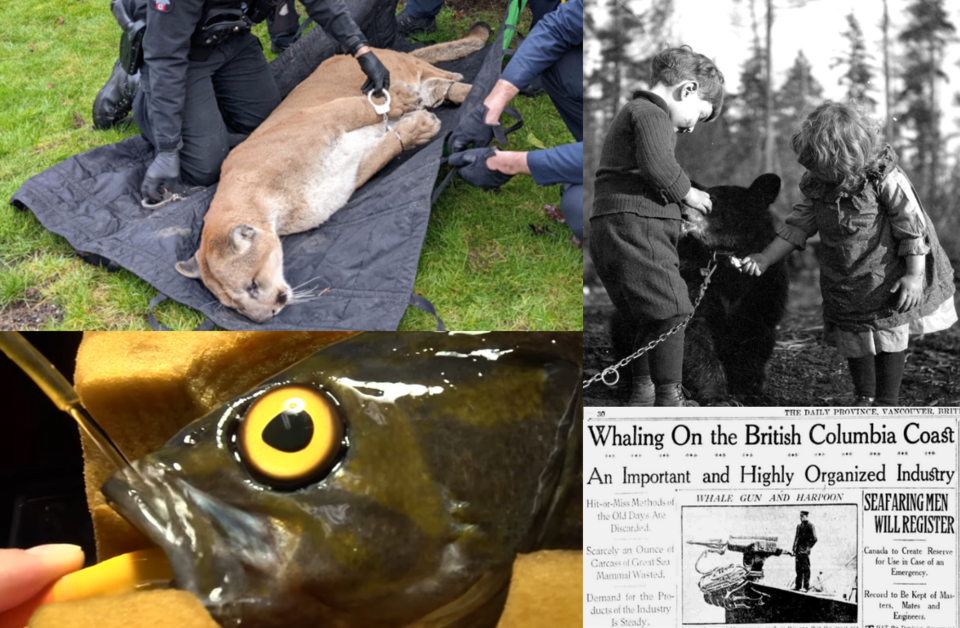Vancouver, as a relatively young city with plenty of nature around it, has plenty of non-human residents.
Raccoons, seagulls, seals and plenty of others regularly share territory with people, and generally it goes fairly well. There are also the animals in captivity, which are much more reliant on humans, like those at the aquarium. And, of course, there are the working animals and pets, which have more symbiotic relationships.
Over the years, though, there's been plenty of interaction between animals and people. Some of it has been good, some of it has been bad, and in some cases it depends on who you are.
In recent years there's been plenty of animal activity that's attracted local and internal media attention, from Canuck the crow to the Chinatown otter to the paw-holding otters of the Vancouver Aquarium.
However, a lot more goes on between the feathered, furry or fishy friends we share the city with. Here are five animal stories that may have been forgotten.
1. A cougar had to be put in hand cuffs
Ignoring the obvious jokes about about the slang term "cougar," this story played out in Maple Ridge in 2022.
A cougar was reported in a suburban area in February, and initially there were concerns the big cat would have to be euthanized.
Luckily, though, conservation officers were able to tranquilize it.
However, something needed to be down to make sure the cat didn't wake up and cause immediate havoc. So local RCMP officers offered up some handcuffs to keep the paws restrained.
Luckily the cat was relocated without (further) incident.
2. Whale meat for sale
Nowadays whales hold a special place for many locals who are in awe of the massive mammals.
However, a century ago, Vancouverites had a very different view of them; they were considered an economic opportunity, with whaling an active industry.
One headline in the Vancouver Daily Province n 1918 declares "Whaling on the British Columbia Coast an Important and Highly Organized Industry"
It goes on to describe all the positives of the industry on Vancouver, from the introduction of whale margarine to the market, to the adventures to be had whaling to a recent event demonstrating the usefulness of whale products in New York City where one of the dishes was "Planked Whale Steak a la Vancouver."
In fact, the introduction of whale steaks in Vancouver got its own media attention; one headline announced "Whale Steak Enters Local Market Friday" and explains Vancouver was following the lead of other cities like Victoria and San Francisco.
Steaks were $0.10 per lbs.
Other articles from later years note the technological advancements made on the West Coast and notes about 400 whales were being caught in B.C.'s waters per year. In one 1922 story the story of hunting a blue whale is told.
Commercial whaling officially ended in B.C. in the 1940s. Attitudes about whales in Vancouver seems to have shifted quickly, as Greenpeace, which started in Vancouver as an anti-nuclear weapons testing group, launched an anti-commercial whaling campaign less than 30 years later, as a their second target.
3. A prosthetic eye for fish
Almost a decade ago, vets at the Vancouver Aquarium gave a couple of fish living there prosthetic eyes.
The two rockfish were both missing a single eye (due to cataracts). Because of this, other fish were aggressive to the single-eyed fish, perceiving them as weak.
To counter this, each got the fake eyes, to fake out the other fish.
4. A pet bear cub in Kitsilano
In the city's early days, animal welfare wasn't really a concern.
At the same time, much of the city was still a wild place. In 1911 James Quiney was trying to develop the land and get people to move out there. He and his own family moved to the neighbourhood (where very few settlers were living) in 1908; their house was around 1820 Waterloo St.
Sometime in 1911 a bear was annoying loggers in the area of 16th Avenue and Collingwood Street (the area was still heavily forested) and so it was shot and killed.
However, it was a mother bear, and two cubs were found. So Quiney decided to bring them home as pets for his children.
It's unclear exactly what happened to the two bears, but notes with a photo in the Vancouver archives suggest once they were big they were split up, with one going to the Stanley Park Zoo and one going to the HMCS Rainbow as a mascot.
5. Cat vs. bear
Everyone knows house cats can be tough, but how tough?
One black bear that wandered into North Vancouver wasn't willing to find out. A two-year-old Bengal cat challenged it when they faced off in a driveway, and the black bear decided to jog off instead of fight the cat which was a fraction of its size.
It was all caught on video.



